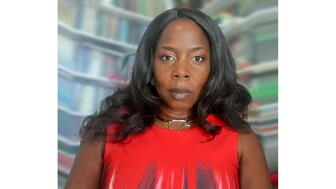“Shell Auranova” is the next generation of the brand’s bridal line, featuring half-bezel engagement rings with bold and fluid designs.
4 Predictions on Retail and Diamond Desire in 2019
It will be a watershed year for man-made diamonds, Editor-in-Chief Michelle Graff writes.

Last month, I had the pleasure of traveling to sunny Scottsdale, Arizona for the annual Centurion show and of catching up with retailers after the holiday season.
What I mostly heard was this: 2018 was a good year and jewelers were expecting a strong December, but the month took a dive alongside the stock market. And the events of late 2018/early 2019, including the 35-day government shutdown, have left retailers feeling unsure what to expect in the year ahead.
What is certain, however, is that this year is going to be very telling in terms of lab-grown diamonds. How will consumers take to the lines that are out there? Will they buy them for fashion jewelry or engagement rings? Will one brand or company begin to emerge as the dominant player in the space?
Read on for four thoughts on what lies ahead for the jewelry industry in 2019.
1. Retailers are feeling ________ about 2019.
Cautiously optimistic. Concerned. Unsure. These are all words I heard circulating at Centurion after a disappointing December capped off an otherwise strong year in 2018.
What will happen with the trade war? Will there be another shutdown (this was talked about at Centurion, although the answer now seems to be no)? How much did the first one shake up consumers?
Are we headed for a recession? Recessions are especially problematic for jewelry because it’s a discretionary purchase; you don’t need to replace a ring the same way you need to replace a car or a refrigerator. As one retailer put it: “We’re the first thing to go.”
Another word that came up: nervous, and it’s not just retailers who are nervous.
“I think everybody is just nervous about everything,” one retailer from the south shared.
She said she feels like she has the right merchandise and marketing in place at her store, but whether people will buy is the big unknown at this point. She also noted that looming ahead of 2019 is a presidential election year and an election always “screws things up.”
Feel free to fill in the blank with your own adjectives in the comments section below.
2. The year will tell us a lot about how consumers view diamonds, and Valentine’s Day will be the first big test.
A head-spinning number of headlines about lab-grown diamonds hit the internet every day, but I think they all can be boiled down to this:
Consumers are going to buy them, though in what quantities and for what purposes remains to be seen.
My guess: They will take a big bite out of the middle market, particularly for lower-priced fashion jewelry.
Yes, some will buy lab-grown diamond engagement rings, but I think the bulk of man-made diamond sales will be to those consumers who say, “Hey, I can get a nice version of this diamond earring/necklace/bracelet for less. Who cares about the romance of it coming from the Earth? I’m saving money, and it’s a nice gift for myself/my daughter/my best friend.”
As I noted above, however, this is just a guess, and time will ultimately tell what consumers want—lab-grown or mined—and what they want it for, with 2019 being a watershed moment in that story.
How will, for example, J.C. Penney and Macy’s do with “Grown With Love,” the line featuring diamonds grown mainly by WD Lab Grown Diamonds and set in jewelry manufactured, distributed and marketed by Richline? Will they sell enough to continue those lines?
How will Lightbox fare, and will De Beers continue to push the envelope, introducing bigger and better stones and more styles, including rings?

What about fashion lines like Atelier Swarovski x Stephen Webster? How well will those sell, and will the designers who made them keep going? Will we see one designer come up with that have-to-have design using man-made diamonds and emerge as the dominant player?
And what about the diamond growers themselves, companies like Diamond Foundry, the California-based company that experimented with, but ultimately didn’t make it in, brick-and-mortar retail? What will their role in the future of the industry look like?
3. Smart companies will stop and think.
In addition to acting as a gauge on consumers’ appetite for man-made diamonds, 2019 is going to be a good year for those selling diamonds today—man-made or natural—to evaluate the market for diamond jewelry going forward.
Some questions that spring to mind include:
--How are changing societal attitudes toward marriage in the U.S. going to impact demand for diamonds, given that engagement rings represent a big chunk of the market?
People are getting married later, often living together and/or having children first.
Or they’re not getting married at all. The U.S. Census Bureau released a “Families and Living Arrangements” table in 2018 that showed that single-person households comprised 28 percent of all households in the U.S. last year. In 1960, that number was 13 percent. The table also showed that 32 percent of all adults age 15 and over have never been married.
Are these long-term trends (I would say yes, for a variety of reasons) and, if so, is diamond marketing prepared to evolve to reflect that?
--How will diamonds stand up in the face of increased competition and, for some groups, declining discretionary income?
There are so many things to spend money on today, aren’t there? As The Wedding Report founder Shane McMurray noted in my story on engagement ring spending, there’s lattes and dinners out and gadgets and clothes, not to mention to the rise in the amount people are spending on what is generally referred to as “wellness”—special vitamins, yoga classes, boutique gym memberships, juice cleanses, etc.
Add to this the fact that many people’s wages aren’t keeping pace with the cost of living, and it equals less money for everything that’s not necessary.
--For those with plenty of discretionary income, what is the No. 1 luxury item that’s taking money away from diamond jewelry?
I would guess it’s not a tangible item, like a handbag or a pair of shoes, but rather experiences, particularly travel. Is there a way to compete with that?

4. Well-known retailers will continue to file for bankruptcy.
This last one is a bit of a cheat, as we’re less than 50 days into the year and, already, we’ve seen seven retailers go Chapter 11, according to Retail Dive’s running list of bankruptcy victims for the year. Among them were long-time mall staples Things Remembered, Gymboree and Charlotte Russe.
So which stores that carry fine jewelry are in danger in 2019?
I predicted in early 2018 that Sears would cease to exist and while it has risen from the ashes, it’s hard to imagine what it can do to make itself relevant again and stay in business.
J.C. Penney is another retailer we’ve been watching for a while, and Neiman Marcus is also a name that keeps popping up on various bankruptcy watch lists, with some predicting that 2019 could be on par with 2017 in terms of the number of retailers going Chapter 11.
The Latest

Boucheron and Pomellato performed well in an otherwise bleak quarter for Kering amid struggles at Gucci.

The company said it expects sightholders to remain “cautious” with their purchasing due to all the unknowns around the U.S. tariffs.

Six new retail businesses were selected for the 2025 program, which began in January.

Sponsored by the Gemological Institute of America


A third-generation jeweler, Ginsberg worked at his family’s store, Ginsberg Jewelers, from 1948 until his retirement in 2019.

The company failed to file its quarterly reports in a timely manner.

The risk of laboratory-grown diamonds being falsely presented as natural diamonds presents a very significant danger to consumer trust.

The organization also announced its board of directors.

Charms may be tiny but with their small size comes endless layering possibilities, from bracelets to necklaces and earrings.


Located in Valenza, the now 355,000-square-foot facility includes a new jewelry school that’s open to the public, Scuola Bulgari.

Paola Sasplugas, co-founder of the Barcelona-based jewelry brand, received the Fine Jewelry Award.

A platinum Zenith-powered Daytona commissioned in the late ‘90s will headline Sotheby’s Important Watches sale in Geneva next month.

The basketball stars wear men’s jewelry from the “Curb Chain” collection.

The Signet Jewelers-owned retailer wants to encourage younger shoppers to wear fine jewelry every day, not just on special occasions.

The 21 pieces, all from a private collector, will be offered at its Magnificent Jewels auction next month.

Lilian Raji answers a question from a reader who is looking to grow her jewelry business but has a limited marketing budget.

GCAL by Sarine created the new role to sharpen the company’s focus on strategic partnerships and scalable expansion.

The Indiana jeweler has acquired Scottsdale Fine Jewelers in Scottsdale, Arizona.

“Cartier: Design, Craft, and Legacy” opened earlier this month at the Victoria and Albert Museum in London.

Van Cott Jewelers in Vestal, New York, is hosting a going-out-of-business sale.

Industry veteran Samantha Larson has held leadership roles at Borsheims, McTeigue & McClelland, Stuller, and Long’s Jewelers.
The two organizations will hold the educational event together this fall in Mississippi.

The entrepreneur and “Shark Tank” star will share his top tips for success.

The Ukrainian brand’s new pendant is modeled after a traditional paska, a pastry often baked for Easter in Eastern European cultures.

The jeweler has announced a grand reopening for its recently remodeled location in Peoria, Illinois.

The “Strong Like Mom” campaign features moms who work at Tiffany & Co. and their children.



























